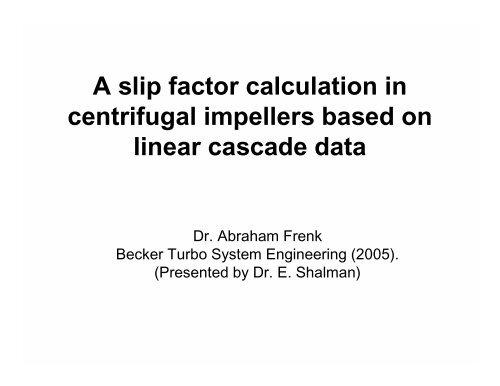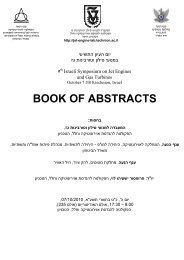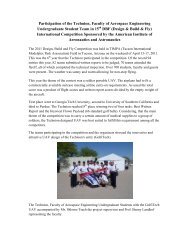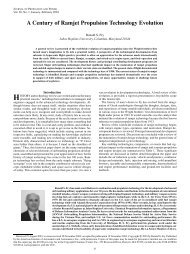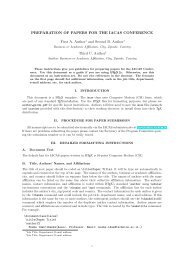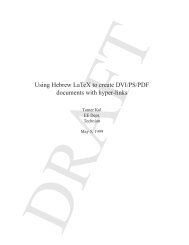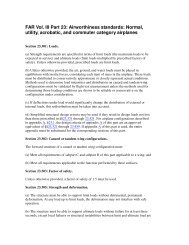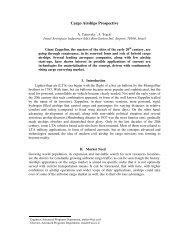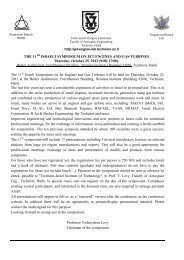A slip factor calculation in centrifugal impellers based on linear ...
A slip factor calculation in centrifugal impellers based on linear ...
A slip factor calculation in centrifugal impellers based on linear ...
Create successful ePaper yourself
Turn your PDF publications into a flip-book with our unique Google optimized e-Paper software.
A <str<strong>on</strong>g>slip</str<strong>on</strong>g> <str<strong>on</strong>g>factor</str<strong>on</strong>g> <str<strong>on</strong>g>calculati<strong>on</strong></str<strong>on</strong>g> <str<strong>on</strong>g>in</str<strong>on</strong>g><br />
<str<strong>on</strong>g>centrifugal</str<strong>on</strong>g> <str<strong>on</strong>g>impellers</str<strong>on</strong>g> <str<strong>on</strong>g>based</str<strong>on</strong>g> <strong>on</strong><br />
l<str<strong>on</strong>g>in</str<strong>on</strong>g>ear cascade data<br />
Dr. Abraham Frenk<br />
Becker Turbo System Eng<str<strong>on</strong>g>in</str<strong>on</strong>g>eer<str<strong>on</strong>g>in</str<strong>on</strong>g>g (2005).<br />
(Presented by Dr. E. Shalman)
Abstract<br />
Accurate model<str<strong>on</strong>g>in</str<strong>on</strong>g>g of the flow <str<strong>on</strong>g>slip</str<strong>on</strong>g> aga<str<strong>on</strong>g>in</str<strong>on</strong>g>st directi<strong>on</strong><br />
of rotati<strong>on</strong> is essential for correct predicti<strong>on</strong> of the<br />
<str<strong>on</strong>g>centrifugal</str<strong>on</strong>g> impeller performance. The process is<br />
characterized by a <str<strong>on</strong>g>slip</str<strong>on</strong>g> <str<strong>on</strong>g>factor</str<strong>on</strong>g>. Most correlati<strong>on</strong>s<br />
available for <str<strong>on</strong>g>calculati<strong>on</strong></str<strong>on</strong>g> of the <str<strong>on</strong>g>slip</str<strong>on</strong>g> <str<strong>on</strong>g>factor</str<strong>on</strong>g> use<br />
parameters characteriz<str<strong>on</strong>g>in</str<strong>on</strong>g>g basic impeller geometry<br />
(review of Wiesner (1967) and Backstrom (2006)).<br />
Approach presented below is <str<strong>on</strong>g>based</str<strong>on</strong>g> <strong>on</strong> reducti<strong>on</strong> of<br />
radial cascade to equivalent l<str<strong>on</strong>g>in</str<strong>on</strong>g>ear cascade. The<br />
reducti<strong>on</strong> allows to calculate characteristics of<br />
radial blade row us<str<strong>on</strong>g>in</str<strong>on</strong>g>g well established<br />
experimental data obta<str<strong>on</strong>g>in</str<strong>on</strong>g>ed for l<str<strong>on</strong>g>in</str<strong>on</strong>g>ear cascades,<br />
diffusers and axial blade rows.<br />
2
Rotors with splitters or with high load<str<strong>on</strong>g>in</str<strong>on</strong>g>g must be<br />
divided <str<strong>on</strong>g>in</str<strong>on</strong>g>to few radial blade rows. In the case of<br />
multiple rotor blade rows the <str<strong>on</strong>g>slip</str<strong>on</strong>g> angle is calculated<br />
for each blade row. The <str<strong>on</strong>g>slip</str<strong>on</strong>g> angle of the rotor is a<br />
sum of the <str<strong>on</strong>g>slip</str<strong>on</strong>g> angles obta<str<strong>on</strong>g>in</str<strong>on</strong>g>ed for each row.<br />
Suggested reducti<strong>on</strong> of radial blade rows allows also<br />
calculat<str<strong>on</strong>g>in</str<strong>on</strong>g>g of other parameters essential for impeller<br />
design.<br />
Suggested method allows also determ<str<strong>on</strong>g>in</str<strong>on</strong>g>e additi<strong>on</strong>al<br />
causes <str<strong>on</strong>g>in</str<strong>on</strong>g>fluenc<str<strong>on</strong>g>in</str<strong>on</strong>g>g <str<strong>on</strong>g>slip</str<strong>on</strong>g> <str<strong>on</strong>g>factor</str<strong>on</strong>g>. The <str<strong>on</strong>g>slip</str<strong>on</strong>g> <str<strong>on</strong>g>factor</str<strong>on</strong>g><br />
depends not <strong>on</strong>ly <strong>on</strong> parameters characteriz<str<strong>on</strong>g>in</str<strong>on</strong>g>g<br />
basic impeller geometry, but <strong>on</strong> difference of <str<strong>on</strong>g>in</str<strong>on</strong>g>let<br />
flow angle from stall flow angle. In the rotors with the<br />
same basic geometry parameters <str<strong>on</strong>g>slip</str<strong>on</strong>g> <str<strong>on</strong>g>factor</str<strong>on</strong>g><br />
depends <strong>on</strong> the length of the blade. Slip <str<strong>on</strong>g>factor</str<strong>on</strong>g><br />
<str<strong>on</strong>g>in</str<strong>on</strong>g>creases with blade length.<br />
3
Axial compressor Centrifugal compressor<br />
4
Slip flow <str<strong>on</strong>g>in</str<strong>on</strong>g> Centrifugal compressor<br />
Busemann (1928) called this<br />
displacement flow;<br />
other authors refer to its<br />
rotat<str<strong>on</strong>g>in</str<strong>on</strong>g>g cells as<br />
relative eddies.<br />
C 2<br />
C u2<br />
C a2<br />
σ = 1−<br />
v R s<str<strong>on</strong>g>in</str<strong>on</strong>g> β<br />
s 2 2k<br />
π = Ω<br />
θ<br />
π s<str<strong>on</strong>g>in</str<strong>on</strong>g> β<br />
σ = 1−<br />
Z<br />
2k<br />
vθ s<br />
ΩR<br />
2<br />
Stodola (1927)<br />
(def<str<strong>on</strong>g>in</str<strong>on</strong>g>iti<strong>on</strong>)<br />
2k<br />
Z<br />
5
Axial compressor Centrifugal compressor<br />
X f<br />
Howell (1945)<br />
Deviati<strong>on</strong> angle δ = β 2 - β 2k .<br />
2 ( 2 ) + 0.<br />
002(<br />
β δ )<br />
( 0.<br />
23<br />
) θ t<br />
δ +<br />
= x f<br />
2k<br />
t<br />
c<br />
σ = 1− − β<br />
u<br />
σ = 1−<br />
C u<br />
Z-number of blades<br />
Slip <str<strong>on</strong>g>factor</str<strong>on</strong>g> σ or <str<strong>on</strong>g>slip</str<strong>on</strong>g> angle δ = β 2 - β 2k .<br />
( tan(<br />
β + δ ) ( ) )<br />
a2<br />
2<br />
2k<br />
tan<br />
s<str<strong>on</strong>g>in</str<strong>on</strong>g> β<br />
Z<br />
0.<br />
7<br />
2k<br />
C a<br />
2k<br />
(Wiesner)<br />
2k<br />
6
∆P<br />
ρ w<br />
1<br />
General Inviscid<br />
∆P<br />
ρ w<br />
eqv<br />
2<br />
1<br />
1<br />
2<br />
2 ( 2 ) + 0.<br />
002(<br />
β δ )<br />
( 0.<br />
23<br />
) θ t<br />
δ +<br />
= x f<br />
2k<br />
W 1<br />
C a1<br />
2<br />
1<br />
β 1,eqv<br />
2<br />
⎛ w<br />
= 1−<br />
⎜<br />
⎝ w<br />
⎛ w<br />
= 1−<br />
⎜<br />
⎝ w<br />
2<br />
1<br />
⎞<br />
⎟<br />
⎠<br />
2<br />
W 2<br />
2<br />
1<br />
C a2<br />
⎟ ⎞<br />
⎠<br />
In L<str<strong>on</strong>g>in</str<strong>on</strong>g>ear cascade C a1 = C a2<br />
⎛ cos<br />
= 1−<br />
⎜<br />
⎝ cos<br />
2<br />
β 2,eqv<br />
( β1,<br />
eqv )<br />
( β )<br />
2,<br />
eqv<br />
⎟ ⎞<br />
⎠<br />
2<br />
General blade row<br />
∆P<br />
ρ w<br />
1<br />
2<br />
1<br />
⎛ w<br />
= 1−<br />
2 ⎜<br />
⎝ w<br />
2<br />
1<br />
⎞<br />
⎟<br />
⎠<br />
2<br />
⎛ cos<br />
= 1−<br />
⎜<br />
⎝ cos<br />
( β1)<br />
( β )<br />
2<br />
K D<br />
Equivalent l<str<strong>on</strong>g>in</str<strong>on</strong>g>ear cascade<br />
∆P = ∆P eqv<br />
β 2 =β 2,eqv<br />
( ) = K cos(<br />
)<br />
cos β1<br />
ε − β<br />
β1, eqv D<br />
eqv = β1,<br />
eqv 2<br />
eqv − i + δ θ eqv<br />
2 = β 2 k δ<br />
k i + = 1 β1<br />
ε =<br />
β +<br />
β<br />
7<br />
⎞<br />
⎟ ⎟<br />
⎠<br />
2
Calculati<strong>on</strong> of equivalent pitch (solidity)<br />
β<br />
eqv<br />
2k<br />
, eqv<br />
( ( ) ( ) 2<br />
0.<br />
23 2x<br />
f + 0.<br />
002 β k δ θeqv<br />
teqv<br />
δ +<br />
= 2<br />
b<br />
t eqv<br />
( t + t ) b b ( t ) 1 + t2<br />
( . 23(<br />
2 ) 0.<br />
002(<br />
) ( 1)<br />
2<br />
x + β + δ θ t −<br />
= β2k<br />
+ 0 f<br />
2k<br />
eqv eqv<br />
=<br />
1<br />
2t<br />
c<br />
σ =<br />
1− − β<br />
u<br />
( tan(<br />
β + δ ) ( )<br />
a2<br />
2<br />
2k<br />
, eqv eqv tan<br />
2<br />
2<br />
2<br />
1<br />
=<br />
t<br />
2<br />
2k<br />
, eqv<br />
2t<br />
2<br />
8
( ) w / w<br />
( w / w )<br />
2<br />
2<br />
( ) = K cos(<br />
)<br />
cos β<br />
β1, eqv D<br />
Calculati<strong>on</strong> of the coefficient K D<br />
1. Influence of the channel height h.<br />
Stratford (1959) obta<str<strong>on</strong>g>in</str<strong>on</strong>g>ed the height (h) of the diffuser<br />
with given length (b) that has maximal static pressure<br />
rise coefficient. The velocity ratio w 2 /w 1 depends <strong>on</strong> the<br />
ratio b/h. The experimental data for l<str<strong>on</strong>g>in</str<strong>on</strong>g>ear cascade<br />
were obta<str<strong>on</strong>g>in</str<strong>on</strong>g>ed for h=2b. The experimental data of<br />
Stafford may be approximated by equati<strong>on</strong><br />
Experimental data for diffusers<br />
1<br />
1<br />
h=<br />
2b<br />
=<br />
⎛<br />
⎜<br />
⎝<br />
2b<br />
h<br />
1<br />
⎞<br />
⎟<br />
⎠<br />
0.<br />
1<br />
9
W 1<br />
C a1<br />
Calculati<strong>on</strong> of the coefficient K D<br />
β 1,eq<br />
v<br />
2. Influence of the ratio C a1/C a2.<br />
Cascade with c<strong>on</strong>stant height and solidity:<br />
w 2 =<br />
w<br />
1<br />
K<br />
c<br />
c<br />
T<br />
a2<br />
a1<br />
=<br />
cos<br />
cos<br />
c<br />
c<br />
a2<br />
a1<br />
( β ) 1<br />
( β )<br />
If the solidity is changed, then velocity ratio <str<strong>on</strong>g>in</str<strong>on</strong>g> the<br />
equivalent cascade must be multiplied by the pitch ratio<br />
w 2 =<br />
w<br />
1<br />
W 2<br />
KT<br />
C a2<br />
β 2,eq<br />
v<br />
cos<br />
cos<br />
( ) = K cos(<br />
)<br />
cos β<br />
β1, eqv D<br />
( β ) 1<br />
( β ) 2<br />
1<br />
t<br />
t<br />
1<br />
2<br />
2<br />
⎛<br />
⎜<br />
⎝<br />
2b ⎞<br />
⎟⎠<br />
h<br />
0.<br />
1<br />
10
W 1<br />
K<br />
Calculati<strong>on</strong> of the coefficient K D<br />
C a1<br />
In General case<br />
D<br />
β 1,eq<br />
v<br />
=<br />
( ) = K cos(<br />
)<br />
cos β<br />
K<br />
β1, eqv D<br />
W 2<br />
1<br />
2<br />
T<br />
C a2<br />
KT<br />
β 2,eq<br />
v<br />
where<br />
For axial compressors<br />
w<br />
w<br />
2<br />
1<br />
where<br />
1<br />
=<br />
cos<br />
cos<br />
K<br />
( β ) 1,<br />
eqv<br />
( β )<br />
T<br />
2,<br />
eqv<br />
=<br />
c<br />
c<br />
a2<br />
a1<br />
=<br />
t<br />
t<br />
1<br />
2<br />
K<br />
T<br />
cos<br />
cos<br />
( β ) 1<br />
( β )<br />
2<br />
Hence, K T =K D<br />
⎛<br />
⎜<br />
⎝<br />
2b ⎞<br />
⎟⎠<br />
h<br />
(effect of boundary layer separati<strong>on</strong> and blockage)<br />
K<br />
T<br />
=<br />
c<br />
c<br />
a2<br />
a1<br />
t<br />
t<br />
1<br />
2<br />
⎛<br />
⎜<br />
⎝<br />
2b ⎞<br />
⎟⎠<br />
h<br />
0.<br />
1<br />
0.<br />
1<br />
11
Impellers with high blade load<str<strong>on</strong>g>in</str<strong>on</strong>g>g<br />
and splitters<br />
The rotor with splitters<br />
is divided <str<strong>on</strong>g>in</str<strong>on</strong>g>to<br />
sequence of rotors.<br />
Each rotor has the<br />
same number of blades<br />
at <str<strong>on</strong>g>in</str<strong>on</strong>g>let and exit.<br />
For high loaded rotors<br />
the load<str<strong>on</strong>g>in</str<strong>on</strong>g>g of each<br />
equivalent l<str<strong>on</strong>g>in</str<strong>on</strong>g>ear<br />
cascade must be less<br />
then maximal allowed.<br />
12
Impellers with high blade load<str<strong>on</strong>g>in</str<strong>on</strong>g>g<br />
Rotor 1<br />
and splitters<br />
Rotor 2<br />
Calculate <str<strong>on</strong>g>slip</str<strong>on</strong>g> angle<br />
for each rotor.<br />
The <str<strong>on</strong>g>slip</str<strong>on</strong>g> angle of<br />
the rotor is a sum<br />
of the <str<strong>on</strong>g>slip</str<strong>on</strong>g> angles<br />
obta<str<strong>on</strong>g>in</str<strong>on</strong>g>ed for each<br />
row<br />
13
( ) = K cos(<br />
)<br />
cos β<br />
β1, eqv D<br />
High blade load<str<strong>on</strong>g>in</str<strong>on</strong>g>g<br />
1<br />
K<br />
D<br />
=<br />
Stall c<strong>on</strong>diti<strong>on</strong>s<br />
K<br />
1<br />
2K<br />
T<br />
T<br />
K<br />
T<br />
=<br />
c<br />
c<br />
a2<br />
a1<br />
t<br />
t<br />
1<br />
2<br />
⎛<br />
⎜<br />
⎝<br />
2b ⎞<br />
⎟⎠<br />
h<br />
0.<br />
1<br />
14
Maximal pressure gradient<br />
Analysis of experimental data of Howell (1945), Emery (1957),<br />
Bunimovich (1967)allows obta<str<strong>on</strong>g>in</str<strong>on</strong>g><str<strong>on</strong>g>in</str<strong>on</strong>g>g follow<str<strong>on</strong>g>in</str<strong>on</strong>g>g equati<strong>on</strong> for<br />
coefficient of static pressure rise at stall c<strong>on</strong>diti<strong>on</strong>s (maximal<br />
pressure rise)<br />
m<br />
( ) = K cos(<br />
)<br />
cos β<br />
st<br />
β1, eqv D<br />
∆P<br />
2<br />
ρ w<br />
1<br />
=<br />
b<br />
∫<br />
0<br />
1<br />
st<br />
2<br />
⎛<br />
= 1−<br />
⎜<br />
⎝<br />
w<br />
w<br />
2,<br />
st<br />
1,<br />
st<br />
⎞<br />
⎟<br />
⎠<br />
2<br />
1<br />
⎛ cos<br />
= 1−<br />
⎜<br />
⎝ cos<br />
( )<br />
2<br />
β ⎞ 1eqv,<br />
st ⎟<br />
1.<br />
124<br />
=<br />
( β ) ⎟ 1+<br />
m t<br />
2eqv,<br />
st<br />
( w ) ∫<br />
Sucti<strong>on</strong>Side<br />
− w1<br />
db ( w1<br />
− wPr<br />
essureSide)<br />
Parameter mst characterizes type of the cascade. E.g. For<br />
cascades studied by Howell mst =1.<br />
t = t / b is relative pitch of the l<str<strong>on</strong>g>in</str<strong>on</strong>g>ear cascade<br />
b<br />
0<br />
K<br />
D<br />
=<br />
K<br />
K<br />
1<br />
2<br />
T<br />
T<br />
⎠<br />
K<br />
T<br />
db<br />
=<br />
c<br />
c<br />
a2<br />
a1<br />
st<br />
t<br />
t<br />
1<br />
2<br />
⎛<br />
⎜<br />
⎝<br />
2b ⎞<br />
⎟⎠<br />
h<br />
0.<br />
1<br />
15
Compressor Stages used to test the model<br />
1. Stage of turbojet Olympus<br />
2. Stage tested by Stechk<str<strong>on</strong>g>in</str<strong>on</strong>g><br />
3. Stage designed by Beker Eng<str<strong>on</strong>g>in</str<strong>on</strong>g>eer<str<strong>on</strong>g>in</str<strong>on</strong>g>g and tested at<br />
C<strong>on</strong>cept.<br />
4. Stage designed by Beker Eng<str<strong>on</strong>g>in</str<strong>on</strong>g>eer<str<strong>on</strong>g>in</str<strong>on</strong>g>g , not tested<br />
5. Stage C1 (tandem blades) (data from USSR)<br />
6. M<strong>on</strong>ig et al. Trans ASME. Journal of turbomach<str<strong>on</strong>g>in</str<strong>on</strong>g>ery<br />
1993,v115, p.565-571.<br />
7. Stage C9 (data from USSR)<br />
8. Musgrave D., Plehn N.J. Mixed flow stage design and test<br />
results with a pressure ratio of 3:1. ASME Gas turb<str<strong>on</strong>g>in</str<strong>on</strong>g>e<br />
c<strong>on</strong>ference presentati<strong>on</strong> 87-GT-20.<br />
16
Results<br />
510.6<br />
165<br />
60.05<br />
0.612<br />
1.0<br />
1.78<br />
19.9<br />
2.89<br />
6.36<br />
12/24<br />
8<br />
520<br />
161<br />
46.25<br />
0.175<br />
0.56<br />
2.18<br />
6.25<br />
2.75<br />
6.79<br />
18/36<br />
7<br />
425<br />
160<br />
50.47<br />
0.316<br />
0.74<br />
2.0<br />
8.48<br />
2.0<br />
3.86<br />
15/30<br />
6<br />
455<br />
185.3<br />
46.65<br />
0.346<br />
0.25<br />
2.12<br />
9.0<br />
2.7<br />
4.54<br />
27/27<br />
5<br />
550<br />
182.9<br />
56.33<br />
0.641<br />
1.50<br />
2.1<br />
48.28<br />
1.0<br />
3.87<br />
7/14<br />
4<br />
500<br />
189.3<br />
57.48<br />
0.397<br />
1.27<br />
1.89<br />
12.0<br />
0.48<br />
5.23<br />
11/22<br />
3<br />
483<br />
170<br />
32.7<br />
-<br />
0.50<br />
2.30<br />
33.58<br />
3.0<br />
3.95<br />
12<br />
2<br />
472.3<br />
180<br />
57.8<br />
0.695<br />
1.0<br />
1.83<br />
16.99<br />
0.41<br />
4.35<br />
6/12<br />
1<br />
u 2<br />
m/s<br />
(tip<br />
velocity)<br />
c a2<br />
m/s<br />
β 1<br />
(<str<strong>on</strong>g>in</str<strong>on</strong>g>let<br />
flow<br />
angle )<br />
t 2,mean<br />
(outlet<br />
relative<br />
pitch)<br />
t 1,mean<br />
(<str<strong>on</strong>g>in</str<strong>on</strong>g>let<br />
relative<br />
pitch)<br />
β 2k<br />
(outlet<br />
blade<br />
angle)<br />
G<br />
Kg/s<br />
Rotor<br />
pressure<br />
ratio<br />
Z<br />
number<br />
of blades<br />
Rotor<br />
No.<br />
Table 1. Rotor parameters.<br />
1<br />
2<br />
r<br />
r<br />
17
Results<br />
Table 2. Slip <str<strong>on</strong>g>factor</str<strong>on</strong>g> and exit angle.<br />
0.877<br />
0.861<br />
0.887<br />
0.895<br />
0.890<br />
0.893<br />
35.0<br />
35.9<br />
8<br />
0.926<br />
0.931<br />
0.910<br />
0.919<br />
0.934<br />
0.933<br />
17.8<br />
17.9<br />
7<br />
0.896<br />
0.914<br />
0.890<br />
0.908<br />
0.896<br />
0.899<br />
23.0<br />
23.32<br />
6<br />
0.903<br />
0.910<br />
0.876<br />
0.902<br />
0.901<br />
0.915<br />
20.6<br />
20.17<br />
5<br />
0.870<br />
0.834<br />
0.762<br />
0.874<br />
0.875<br />
-<br />
56.3<br />
-<br />
4<br />
0.865<br />
0.880<br />
0.848<br />
0.888<br />
0.888<br />
0.887<br />
27.0<br />
27.0<br />
3<br />
0.840<br />
0.823<br />
0.72<br />
0.840<br />
0.896<br />
-<br />
43.8<br />
-<br />
2<br />
0.784<br />
0.718<br />
0.860<br />
0.832<br />
0.878<br />
0.881<br />
32.0<br />
31.8<br />
1<br />
σ<br />
Eck<br />
σ<br />
Stechk<str<strong>on</strong>g>in</str<strong>on</strong>g><br />
σ<br />
Stodola<br />
σ<br />
Wiesner<br />
σ<br />
Present<br />
work<br />
σ<br />
measured<br />
β 2<br />
Present<br />
work<br />
β 2<br />
measured<br />
Rotor<br />
No.<br />
18
Measured and calculated <str<strong>on</strong>g>slip</str<strong>on</strong>g> <str<strong>on</strong>g>factor</str<strong>on</strong>g> for 6 <str<strong>on</strong>g>impellers</str<strong>on</strong>g><br />
19
Calculated <str<strong>on</strong>g>slip</str<strong>on</strong>g> <str<strong>on</strong>g>factor</str<strong>on</strong>g> for 8 <str<strong>on</strong>g>impellers</str<strong>on</strong>g><br />
20
C<strong>on</strong>clusi<strong>on</strong>s<br />
• Suggested method allow<str<strong>on</strong>g>in</str<strong>on</strong>g>g reducti<strong>on</strong> of<br />
arbitrary rotor blade passage to<br />
equivalent l<str<strong>on</strong>g>in</str<strong>on</strong>g>ear cascade<br />
• Method allows establish<str<strong>on</strong>g>in</str<strong>on</strong>g>g equivalence<br />
between axial and <str<strong>on</strong>g>centrifugal</str<strong>on</strong>g> <str<strong>on</strong>g>impellers</str<strong>on</strong>g><br />
• Method allows calculat<str<strong>on</strong>g>in</str<strong>on</strong>g>g <str<strong>on</strong>g>slip</str<strong>on</strong>g> <str<strong>on</strong>g>factor</str<strong>on</strong>g><br />
<str<strong>on</strong>g>based</str<strong>on</strong>g> <strong>on</strong> well established l<str<strong>on</strong>g>in</str<strong>on</strong>g>ear cascade<br />
correlati<strong>on</strong>s for deviati<strong>on</strong> angle<br />
21


